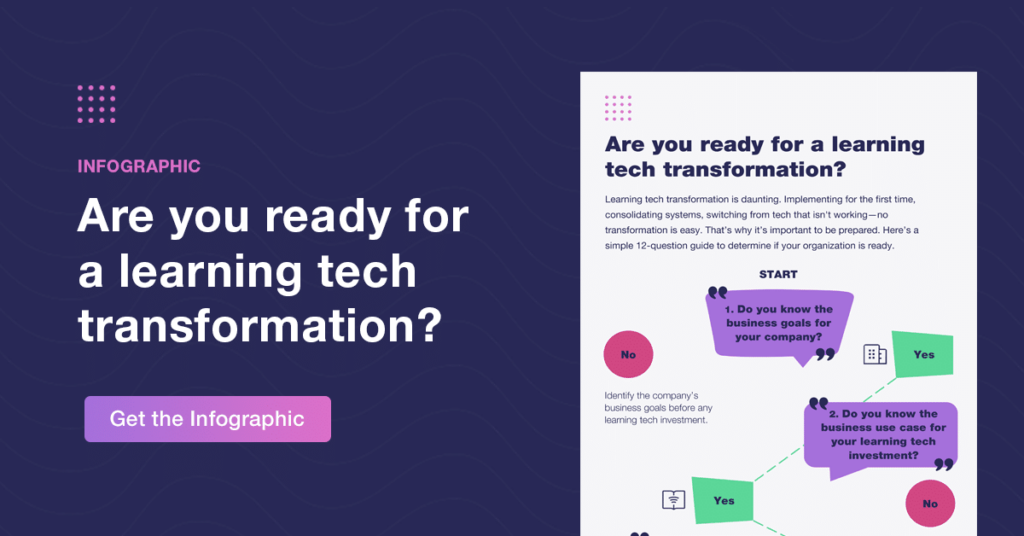April 24, 2023
9 Min. Read

The last three years have been quite an adjustment period for most organizations. The business climate is dynamic and unpredictable, more workers are remote than ever before, and keeping good talent engaged and committed to the company has gotten more challenging.
Right now, organizations are looking to get a handle on how they are going to engage and develop their people moving forward. Companies realize they need to reskill and upskill their employees in a much more fluid and agile way. Additionally, companies that made a hasty digital transformation of their learning technology environment in the immediate wake of the pandemic are starting to realize the choices they made may not have been ideal. Put this all together and it makes for an increased interest in reshaping the learning technology ecosystem to better suit this new environment.
But changing technologies can be a daunting task. So much so that many organizations would rather limp along with what they have than risk a switch. But by conducting proper due diligence and asking themselves the right questions, companies can simplify the process and ensure their next technology selection puts them in a position to meet the future needs of the business.
9 Due Diligence Steps to Better Prepare for a Learning Technology Transformation
1. Business Goals
It seems like it would be a given, but many Learning & Development teams aren’t exactly clear on what the goals of the business really are, let alone how leadership expects to achieve them. Having proper discussions with stakeholders can help crystalize L&D’s mission in service of these goals, which then guides technology selection with the goals in mind.
Questions to ask:
– What are the organizational business goals?
– How can L&D have an impact on them?
– Do we have the right metrics and tools to be able to measure that impact?
2. Use Cases
Figuring out what exactly you need the learning technology to do is critical. This is not a list of features and functionalities. This is an understanding of what the platform will do for the specific learners, managers, admins, and other stakeholders in the organization. It’s understanding how the technology helps make these specific things happen.
Questions to ask:
– Who are the different learner, manager, and admin groups?
– What does each need to do in the system?
– Are there any flows or steps that need to happen for the above? (ex: using SSO to log in)
3. Stakeholder Buy-in
Learning technology should be selected to help achieve business goals, so having stakeholder sponsors or champions on your side is critical. If they know how this technology will help their people and the business succeed, they will support you.
Questions to ask:
– Which groups with this technology touch? (ex: IT)
– What do they need to know about the technology?
– When does it make sense to get them involved and how much?
4. Digital Culture
You have to know your audience. Simply buying the newest or shiniest tech won’t help if nobody can or wants to use it. The solution you buy should match the technology awareness of the audience, or maybe slightly ahead (keep an eye on the future!). Long, intense training on a new system will push engagement in the wrong direction.
Questions to ask:
– What is the technology readiness of the intended audiences?
– Is there a way to build learning into the systems we use today?
– Would adding a new technology be disruptive?
5. Data Security
Make sure you understand all of the implications of a new system. What kind of data will be required? Does the organization need to adhere to any regulations like GDPR? Are there any intellectual property or proprietary information issues to address? Your technology selection needs to be able to handle these situations if necessary.
Questions to ask:
– Are there security and compliance regulations we need to adhere to?
– Do we have access to someone who can help us update our technology to meet new security requirements and regulations?
6. IT
In some cases, IT gets left out of the conversation until implementation day, which leads to disaster. IT counts as one of your business stakeholders. They can help identify possible challenges with networks, security, and integrations early enough in the process to help guide the selection process.
Questions to ask:
– Which IT stakeholders need to be involved?
– What IT requirements or questions do we need to be aware of?
– Is our technology infrastructure conducive to setting up a new learning system?
7. Governance
At this point of the due diligence process, you need to figure out who is going to own what. If you are going to have multiple roles with various layers of permissions/access, the solution needs to be able to provide that. The technology you select should be able to match the way your organization is structured, even if that is expected to evolve over time.
Questions to ask:
– Who will own the implementation and administration of the technology?
– Who will oversee communicating any changes that impact learning and what might those changes be? Ex: regulatory compliance updates.
– Who owns user updates and changes?
8. Flexibility
Setting a learning strategy in stone and never revisiting it is a sure way to ensure L&D fails the business. The business is acting and reacting constantly with minor and major shifts in strategy coming more than once a year. As such, a static L&D strategy won’t point to the right technology solution. Make sure the L&D strategy is in alignment with the business, and the technologies leveraged can aid that agility.
Questions to ask:
– Do we have plans to grow as an organization and can the technology scale with us?
– Do we plan to extend our learning into new areas or modalities?
– How often do we plan to revisit our learning strategy?
9. Current State
What do we currently have at our disposal from a learning technology and learning content perspective? Having a clear picture of the technology ecosystem as far as what is there, what works, and what doesn’t can help narrow the selection process. This is also a good time to review any content libraries for duplicate and outdated material.
Questions to ask:
– What’s working well and what isn’t working well enough with our current learning system(s)?
– Is it time for a content refresh?
– Are there holes that exist in the current learning technology management or related processes?
There are other questions to ask, for sure, but this list can set your organization on the right technology selection path. Without a proper foundation, the process leaves you to the whims and vagaries of an incredibly crowded and complex technology market. In the end, you are not buying a technology, but rather finding a partner that can help you solve challenges and deliver on business goals.
Think you’re ready? Why not find out with our 12-question infographic…




